Welcome to Death Valley, one of the largest, most varied, and craziest national parks to visit in the US! Winter is actually the best time to be there – so there you go, here is our guide to visiting Death Valley in winter 2025 and beyond!
Planning to visit Death Valley from Las Vegas? Check out these wonderful tours!
We love organizing our tours with GetYourGuide – they offer lots of different tours with 24/7 assistance, flexible booking and great prices!
- From Las Vegas: Death Valley Day Tour – discover all the must-see sights around the park!
- From Las Vegas: Death Valley & Rhyolite Ghost Town Day Trip – the best of the park, plus a
- From Las Vegas: Full Day Death Valley Group Tour – includes all the sights mentioned in this article!
- Las Vegas: Death Valley Day Trip w/ Stargazing & Wine Tour – see the best starry sky of your life… with a glass of Californian red!
- From Las Vegas: Death Valley Trekker Tour – a fun day tour on striking pink jeeps!
If you’ve been following this blog, or our social media, you’ll probably know we spent two months on our US Southwest road trip of a lifetime.
During our trip, we visited several US national parks in winter. We hiked in Zion, marvelled at the snowy landscape of Bryce Canyon, toured the desert in Big Bend, got lost amid the dunes in White Sands, and more.
Visiting national parks in the coldest months of the year came with disadvantages – the cold weather, fewer hours of sunlight, and sometimes partial closures.
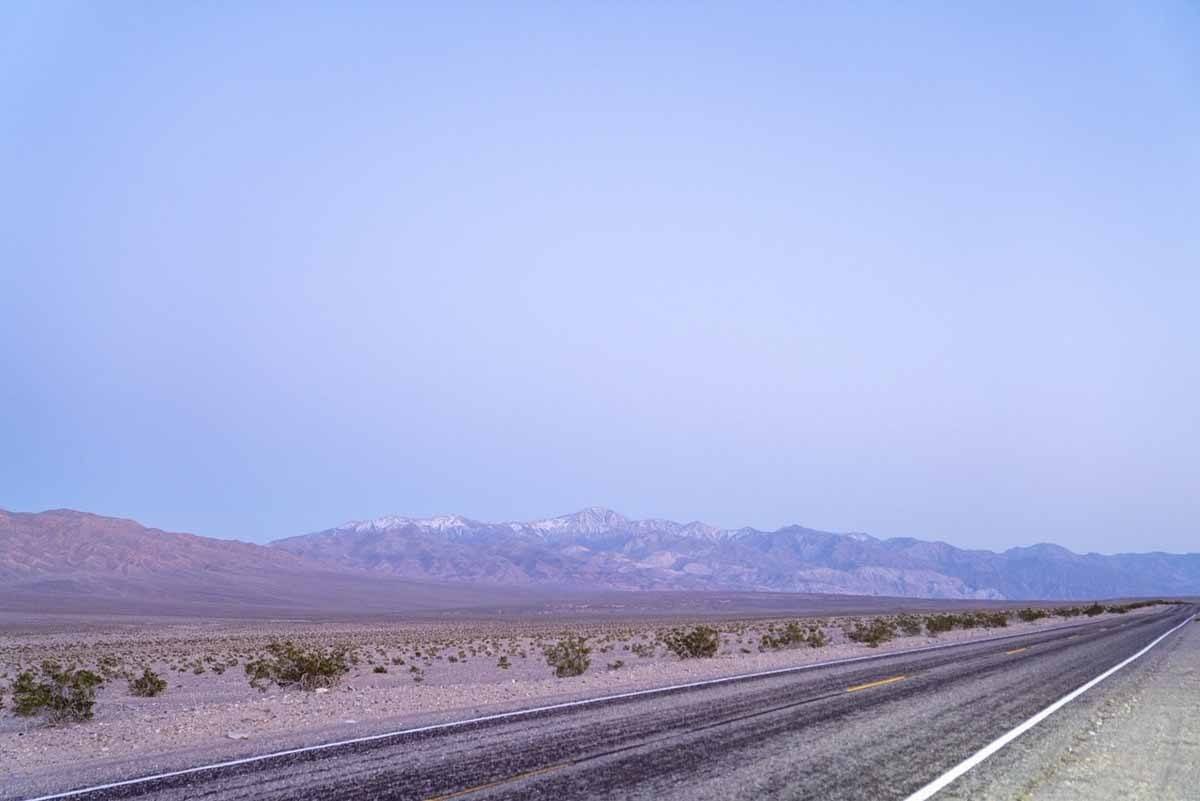
However, advantages more than outweighed problems – the national parks we visited in winter were very, very quiet. Visits were always an enjoyable experience, with no crowds and queues.
Death Valley National Park doesn’t fit into this pattern. Winter is high season in Death Valley – the only season in the year where temperatures are actually bearable, and you can visit and even hike without dreaming of air con.
This means that visiting Death Valley in winter needs to be planned ahead. You need to reserve accommodation in advance if you plan to stay in the national park, and decide where to go – did I mention Death Valley is huge? It’s actually the largest US national park in the Lower 48!
After visiting Death Valley in winter, we’ve put together this guide to make planning easier for you. Let us know if there is any info you wish us to include!

Things to Know About Death Valley in Winter
Death Valley Winter Weather
Death Valley is one of the hottest places on earth, because of a combination of lack of water, elevation below sea level, and rocks in the valley floor and surrounding mountains, trapping the heat in the depression.
Death Valley is also where the hottest temperature ever was recorded on Earth – a whopping 134°F (57°C), recorded at Furnace Creek on July 10, 1913.
In summer, Death Valley is truly scorching. Temperatures top 120°F (49°C), and only dip into the 90s°F (mid-30s°C) at night. Even getting out of a vehicle to walk to a viewpoint becomes hard due to the severe heat – hiking is near impossible unless you have a death wish.
In contrast, winter is a very pleasant time to visit Death Valley. Daytime temperatures are in the 70s°F (between 20-25°C), dropping just above freezing at night. You can hike without breaking into a sweat after 5 seconds, and there’s no need to really worry about rain – it hardly ever rains in Death Valley, in winter or otherwise.
Does it Ever Snow in Death Valley?
In short, the answer is no. It only rains an average of 3/4 days in Death Valley throughout the year, and given that temperatures are well above freezing usually, the chances of enough snowfall to accumulate on the valley floor are very small indeed.
However, don’t forget that not all of Death Valley National Park is below sea level.
The park does indeed include Badwater Basin, the lowest place in North America, at an elevation of 282 feet (86 m) below sea level. However, there’s a huge elevation difference between the lowest and highest point in the park – Telescope Peak, 11,043 feet (3,366 m) high.
You will indeed find snow on Telescope Peak and surrounding mountains, but not on the valley floor where you’re likely to spend the majority of your time in Death Valley in winter.
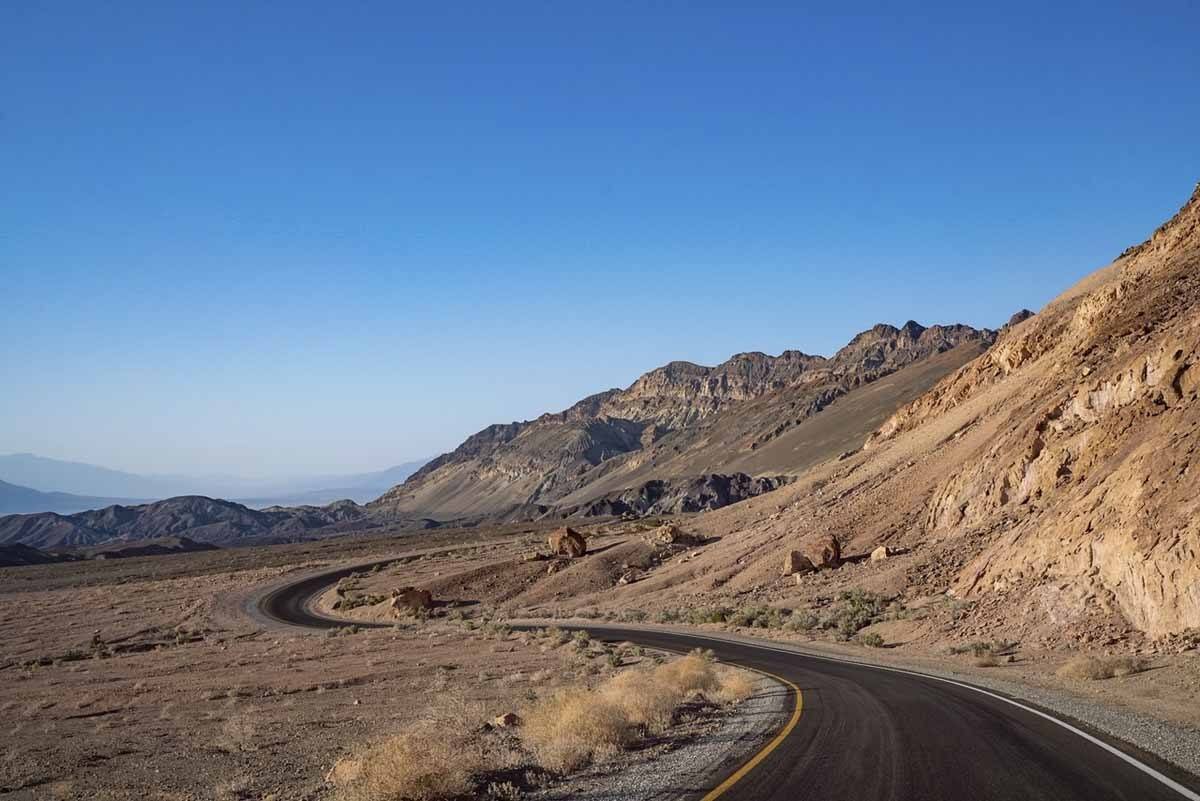
How to Get to Death Valley
Death Valley National Park is in southeastern California, about 150 miles west of Vegas and 185 miles north of Los Angeles.
The park measures 140 miles from north to south, and it’s between 5 and 15 miles wide. As a result, distances to Death Valley largely depend on where in the park you are planning to go. There are two main entrances – Panamint Springs to the west and Death Valley Junction to the east.
Driving time from Vegas is approximately two hours, and you’ll be entering the park from Death Valley Junction.
Visitors coming from California will definitely enter from Panamint Springs. Driving time from Los Angeles is about 4 hours and distance is just over 200 miles, depending where in LA you’ll be leaving from.
From San Francisco, driving time is 8 hours, and distance is around 450 miles. We recommend breaking the trip to visit Sequoia National Park, which is also amazing in winter!
Getting Around Death Valley in Winter
Given its sheer size, the best (and only, really) way to get around Death Valley is by car. Most Death Valley points of interest are located close to Highway 190, crossing the park from north to south, and on a one (long) day you can check out most of them.
It’s also possible to cycle around Death Valley, but please don’t attempt this in any other seasons besides winter, and only if you’re really fit and experienced.
Is Death Valley Busy in Winter?
Death Valley’s high season is in winter, so you may expect to find crowds. You’ll be pleased to know this is rarely the case! The park is so big, and there are so many things to do and see, that even on a weekend or public holiday visitors are likely to be scattered all over.
So, Death Valley in winter is pleasant, AND you are unlikely to be stuck in crowds. This is really a very good reason to add it to your California itinerary!

Best Death Valley Winter Hikes
One of the main reasons to visit Death Valley in winter is that it’s the only time during the year when hiking is actually possible.
Having said that, please be aware that temperatures can soar really quickly in winter as well – the day we visited in mid-Feb, it got to the mid-80s (about 20°C) in the middle of the day, and a seemingly easy hike became strenuous really quickly.
Don’t forget to have plenty of water with you, and avoid hiking in the middle of the day – always prefer morning or late afternoon.
Zabriskie Point Trail
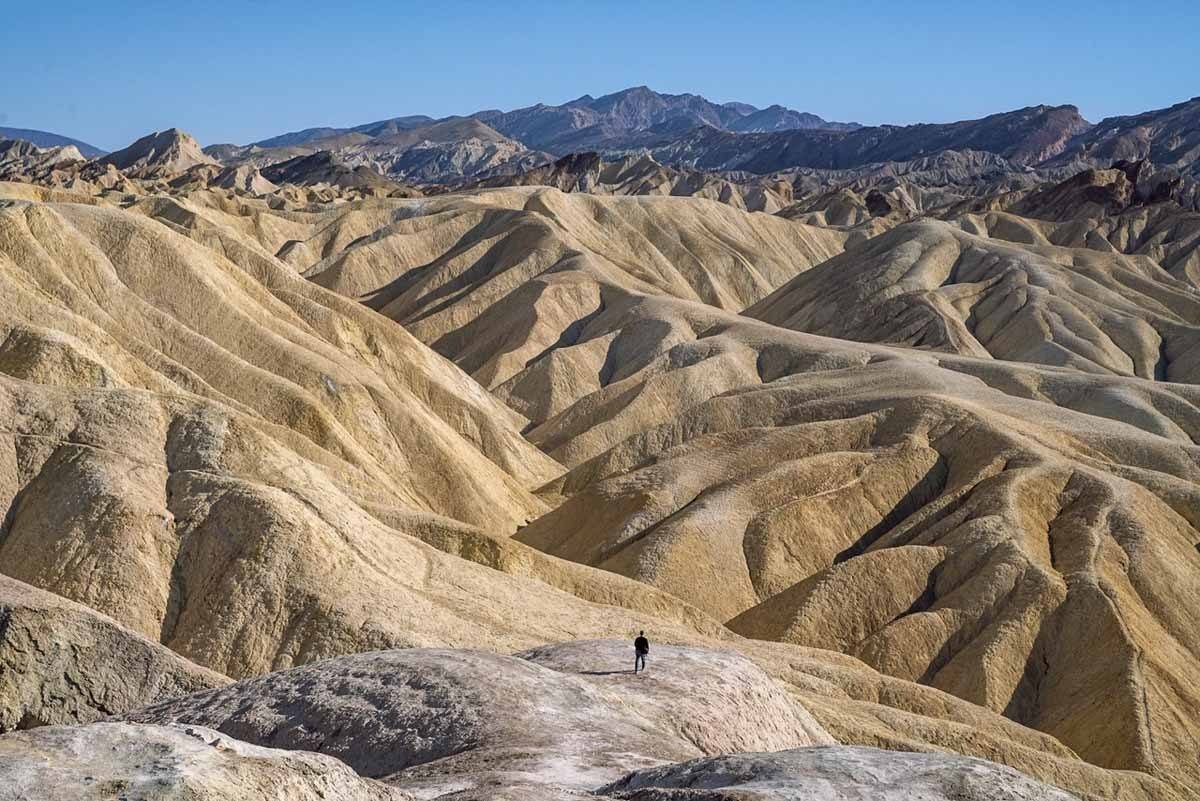
Distance 0.3 miles / Difficulty Easy / Time 30 mins
As far as Death Valley hikes go, this is probably the easiest, a short trail leading to a viewpoint where you can enjoy sweeping views over the Badlands section known as Zabriskie Point.
The hike is paved and doesn’t present technical difficulties, but it’s uphill and in the blazing sun, so it may be hard if it’s hot. Don’t forget to take your water bottle!
If you want to hike deeper into the Badlands at Zabriskie Point, there is also a 2.7 mile loop departing from the viewpoint, taking you close to the rock formations.
A stop in Zabriskie Point is included along this sustainable 7-day tour of American National Parks – don’t miss it!
Darwin Falls
Distance 2.1 miles return /Difficulty Easy / Time 1.5 hours
Wait a second, isn’t Death Valley National park a desert? So, what is a waterfall doing there?
You’ll just have to take this easy yet rewarding hike to explore this oddity, a small but perennial waterfall surrounded by lush vegetation in the middle of the hottest and driest place in North America!
To see it, drive to the Darwin Falls parking lot just off Old Toll Road, only 3 miles from Panamint Springs. The trail is only a mile each way but it requires a bit of scrambling and creek crossing. You’ll see vegetation increase gradually, until you find the falls right in front of you at the end of the trail.
Badwater Basin Crossing
Distance 6.5 miles one way / Difficulty Intermediate / Time up to 4/5 hours
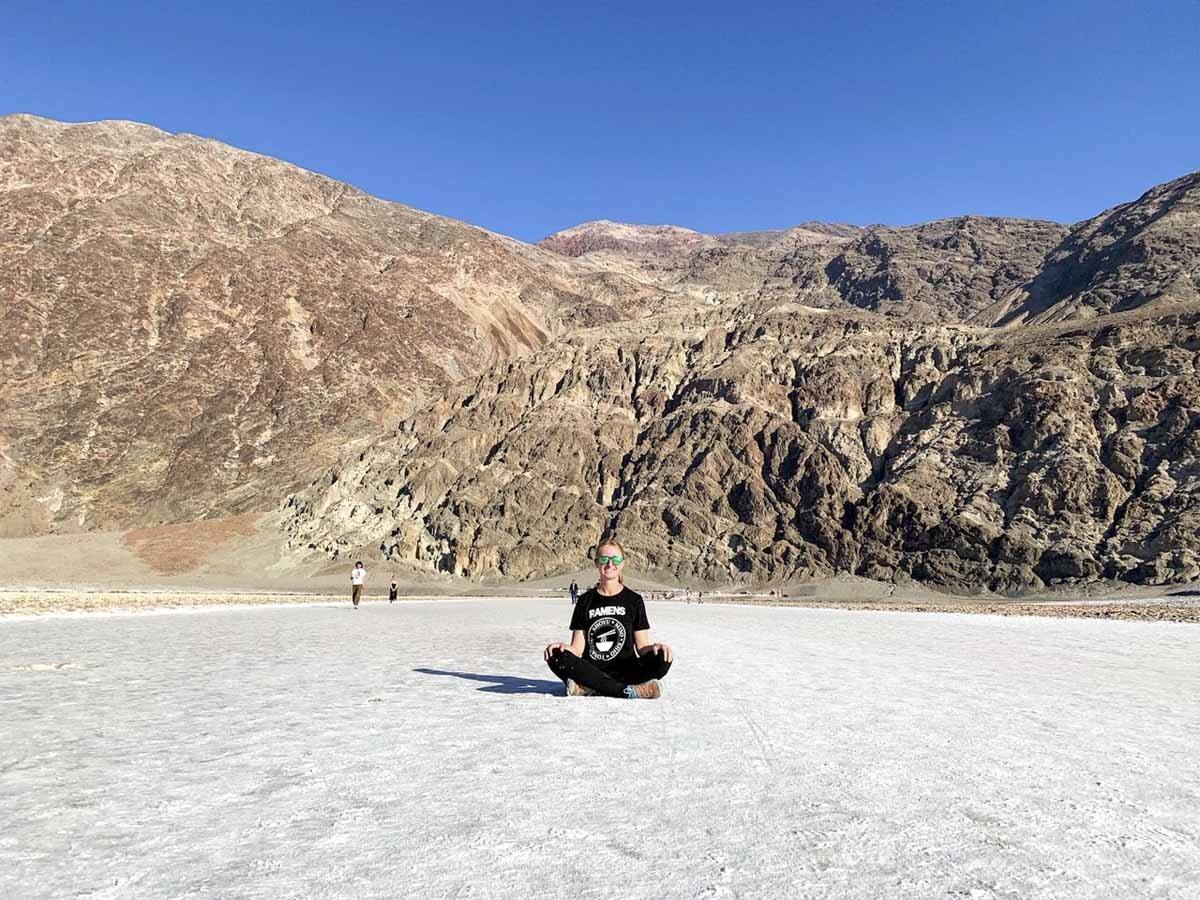
This trail allows you to cross the vast depression known as Badwater Basin, which also includes the lowest place in North America.
Total length is 6.5 miles point-to-point, and it does get kind of tedious after a while, so we don’t actually recommend hiking all of it – just turn back when you get fed up, or else arrange for someone to pick you up.
The trail starts at the parking lot along Badwater Road, and the first mile or so is well beaten, as this is what most people hike. After that, the path gets narrower and less clear, until it disappears completely.
It’s hard to get lost as the landscape is quite open, but don’t underestimate distance. The complete crossing is a full-day affair, and it can get very hot!
Badwater Basin is also one of the coolest places in Death Valley for stargazing, and winter offers perfect conditions – this Death Valley day trip includes stargazing, a fantastic experience!
Best Places to Visit in Death Valley National Park
Part of the appeal of visiting Death Valley in winter (or any other season, really) is the incredible landscape variety, and the opportunity to see several different scenic locations within relatively short driving distance.
The following places can all be visited in one day. I’ve listed them in the same order we visited them, entering the park from the east (closest entrance if you’re driving from Vegas), and ending in Panamint Springs.
Don’t forget that Death Valley is huge, so follow the same order to minimise driving time!
This drive can be the perfect itinerary to follow if you’re in Death Valley for just one day. Let us know what you think!
Dante’s View
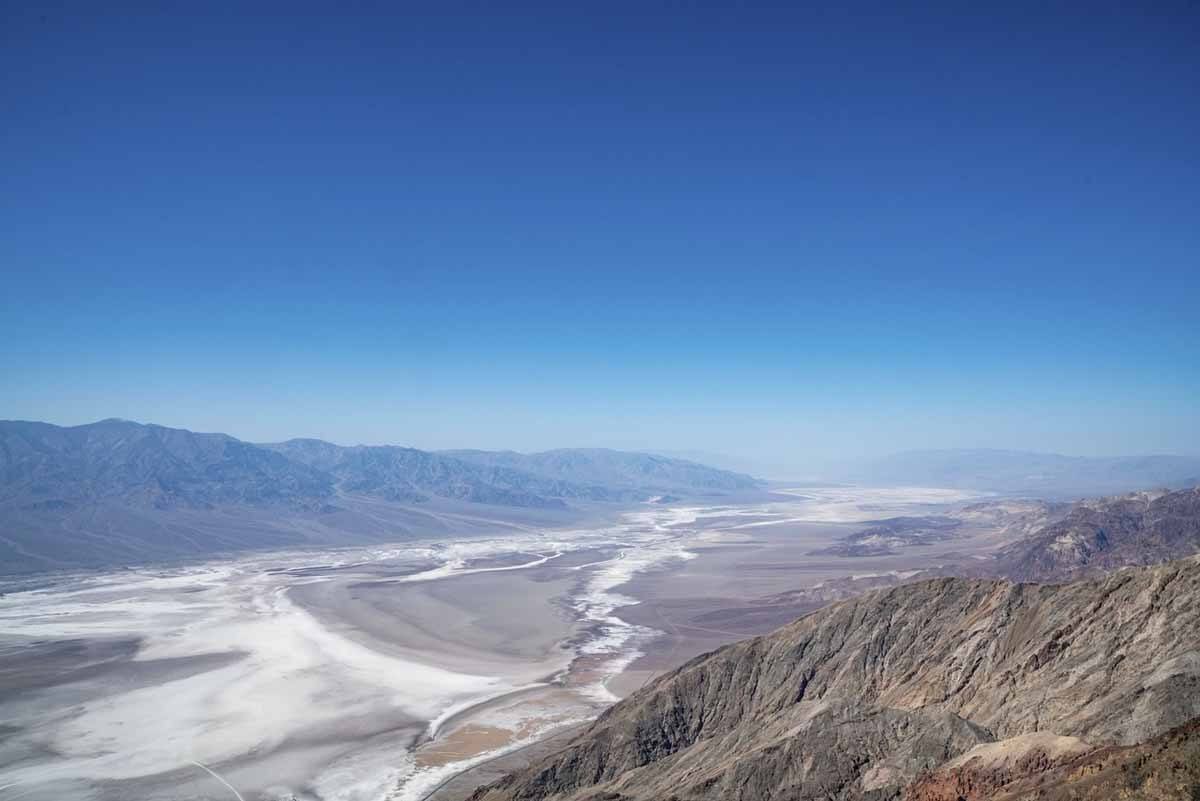
From the east entrance, Dante’s View is only about half an hour drive away. If you wish to start your Death Valley in winter experience with a bang, Dante’s View is the ideal place – a viewpoint on a mountaintop at 5,476 ft (1,669 m), overlooking Death Valley.
It’s the perfect place to get a sweeping view of Death Valley National Park – you can see the entire depression right before you, flanked by mountains. You can also see the shimmering expanse of Devil’s Golf course, which you’ll be visiting later on.
The ‘Dante’ in the place name was chosen in reference to Dante Alighieri and the Divine Comedy.
A stop at Dante’s View is included in this small-group tour of Death Valley NP from Las Vegas, the closest town to the park!
Zabriskie Point
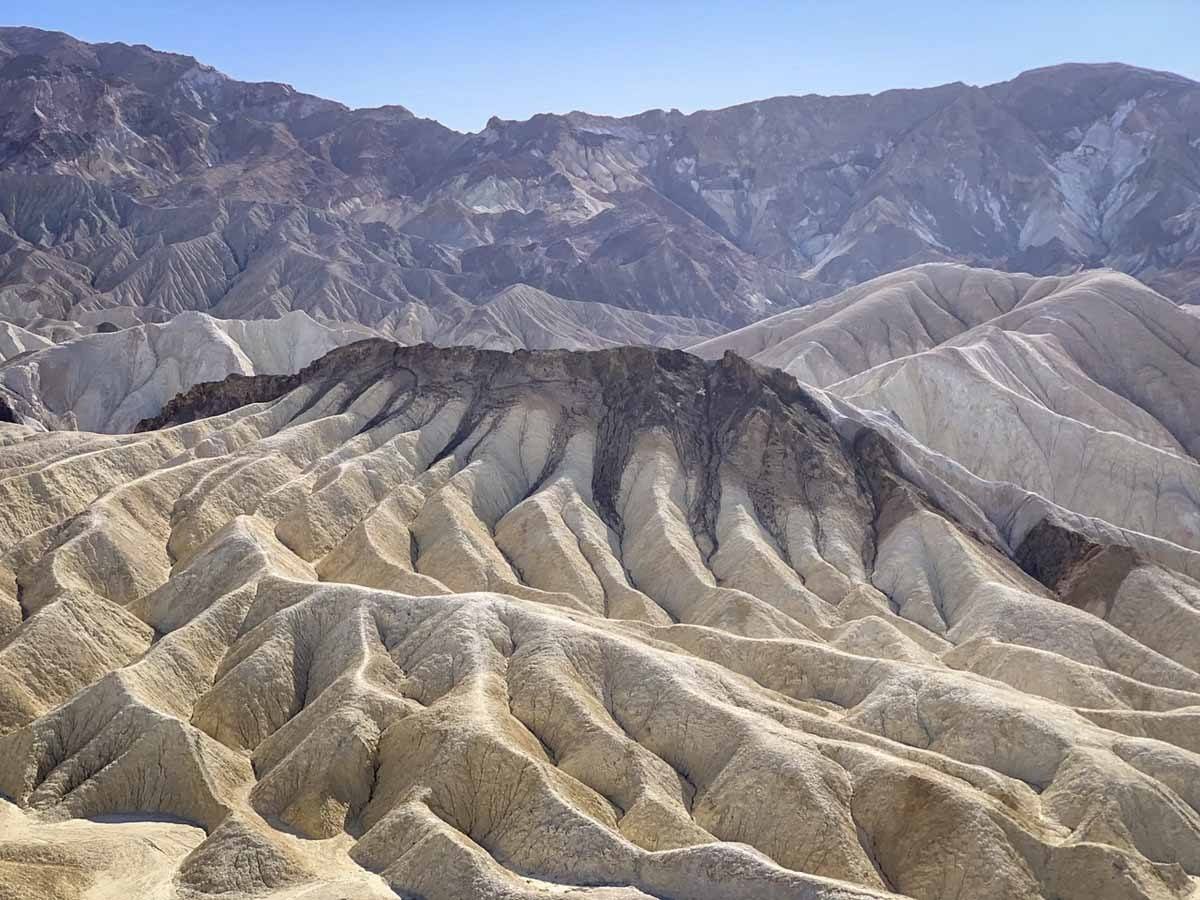
20 miles and about 30 minutes drive from Dante’s Peak you’ll find Zabriskie Point, the most famous Badlands expanse in the national park, known for its colourful rocks.
You can leave your car at the parking lot and follow the short trail described above, or head into the Badlands on a longer trail to get close to the various rock formations.
The colours are due to the fact that the area was once the bottom of an ancient lake – what you see today are sediment layers, worn away by millions of years of erosion.
In the early 20th century, borax was mined in Death Valley. The general manager was Christian Brevoort Zabriskie, after whom the location was named. You may also remember the name from Michelangelo Antonioni’s 1970 film, Zabriskie Point.
On your way in or out of Zabriskie Point, you may also want to drive across Twenty Mule Team Canyon, a short, scenic unpaved road through the badlands named after the 20 mule teams that ferried borax away from the mines.
Devil’s Golf Course
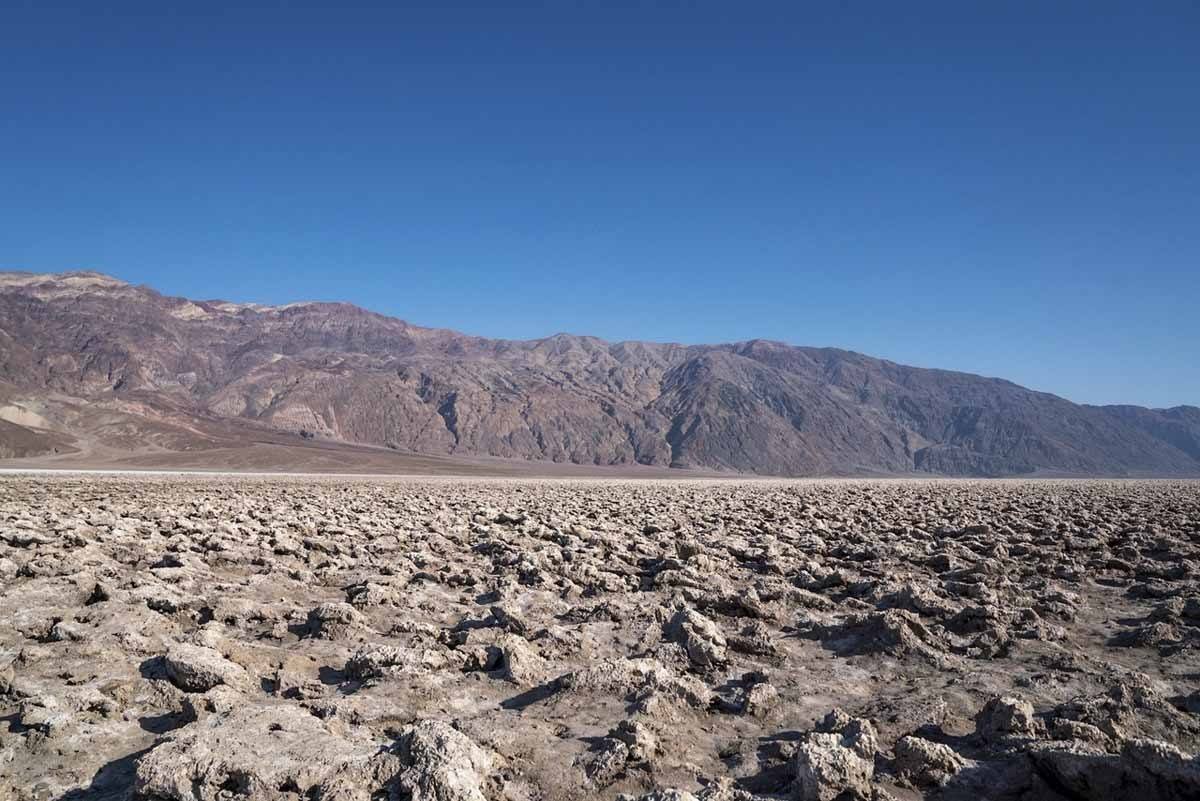
The next location is only 12 miles from Zabriskie Point. Devil’s Golf Course used to be the bottom of a lake – when this evaporated, it left a thick layer of salt, which was eroded over time into sharp, jagged shards, some of which are over two feet high.
The name comes from one of the early National Park Service guidebooks, which described the location saying ‘only the devil could play golf’ there. Nowadays you may indeed find golfers there attempting to play – but be very, very careful as you walk around, as those salt spikes are sharp!
A fun way to visit Devil’s Golf Course is this 4×4 tour of Death Valley NP on bright pink jeep!
Artists Palette

If you thought nothing could beat the colours of Zabriskie Point, think again! There’s a reason why this sedimentary hill is called Artists Palette – from vibrant pink, to ochre and even aquamarine, mineral layers and erosion have created a true colourful masterpiece of nature.
To reach Artists Palette, you’ll have to drive down Artists Drive, a 9-mile scenic drive just off Badwater Road. Don’t forget it’s one way, so you’ll have to drive it south to north, which requires a little detour if you’re coming from Devil’s Golf Course.
Distance from Devil’s Golf Course to Artists Palette is about 15 miles, also considering the scenic drive!
Badwater Basin
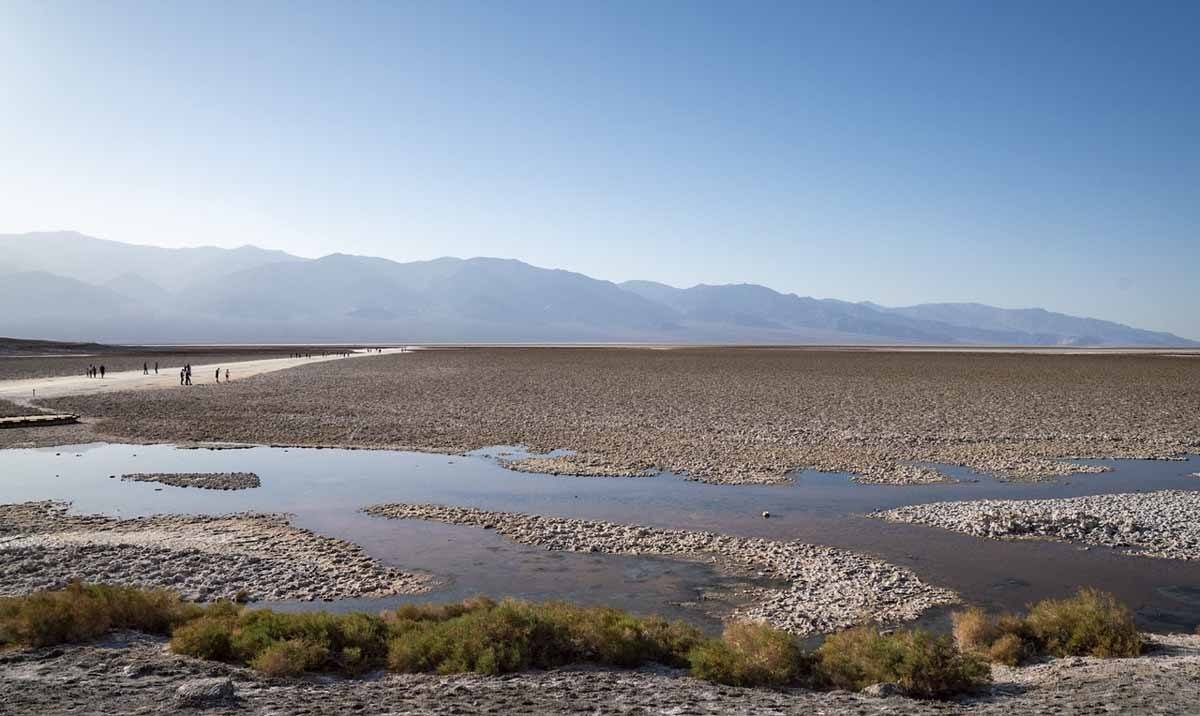
Together with the badlands at Zabriskie Point, Badwater Basin is THE place people associate with the image of Death Valley, a pool of salty water surrounded by salt flats, set in a 200-square mile depression.
As we mentioned before, Badwater Basin also includes the lowest point in North America, at 282 feet below sea level.
There’s a sign marking the spot, which gets crowded with visitors – but you just need to hike a little further to have the place to yourself, surrounded by the giant plains. If you want to hike all the way across, be sure to read the hiking informations we described in the previous section.
Fun fact – as you hike back towards the car park, you’ll see a sign on a mountain right in front of you marking sea level, giving you an idea of how ‘deep’ you are!
Mesquite Flat Sand Dunes
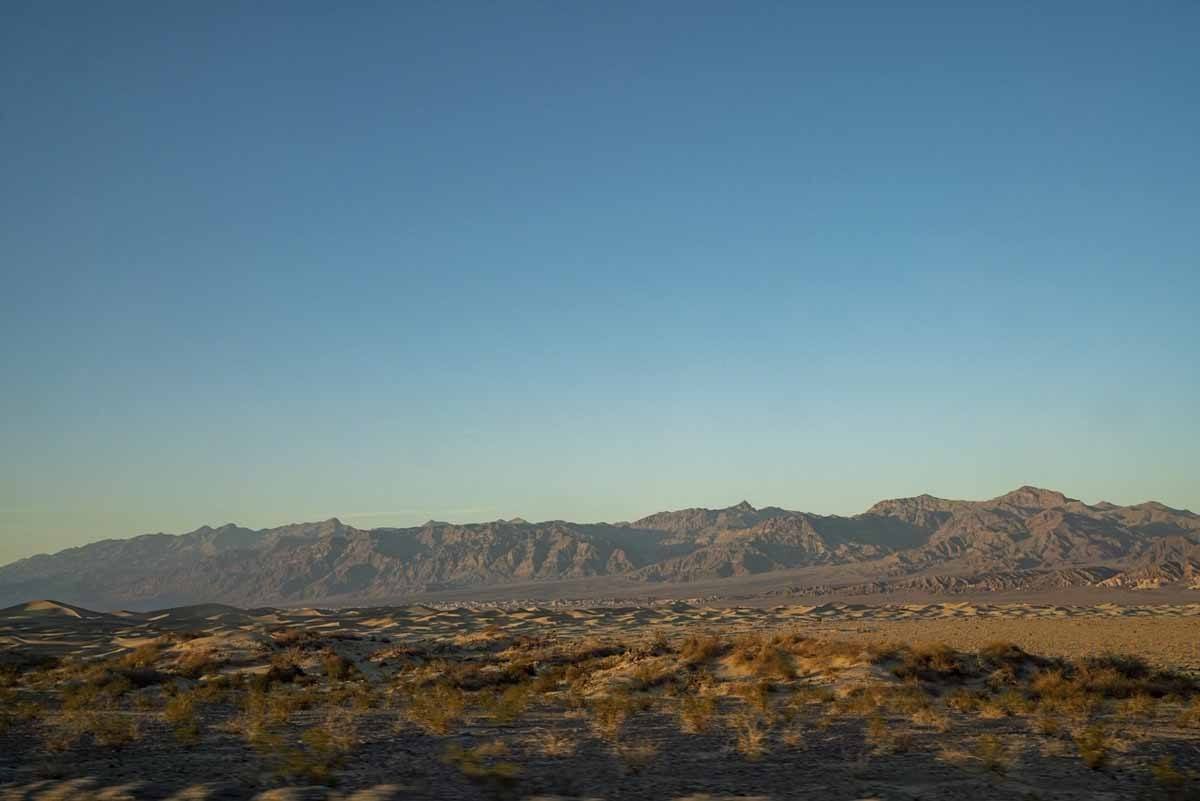
You can’t have a desert without dunes, right? Well, Death Valley delivers also in this department!
Mesquite Flat Sand Dunes is best place in Death Valley National Park to see dunes, especially at sunset. It’s 40 miles from Badwater Basin, not far from Stovepipe Wells were you can also find accommodation, so it’s the ideal conclusion to your 1 day itinerary around Death Valley in winter.
The dunes can get up to 100 feet high, and if you’ve never hiked on dunes before, you’ll soon see how hard it is! There’s no trail as such to follow, but if you’re visiting for sunset you’ll definitely see other people, so there’s no need to worry about getting lost.
After night falls, you’ll just have to look up to see the marvel of a Death Valley starry sky!
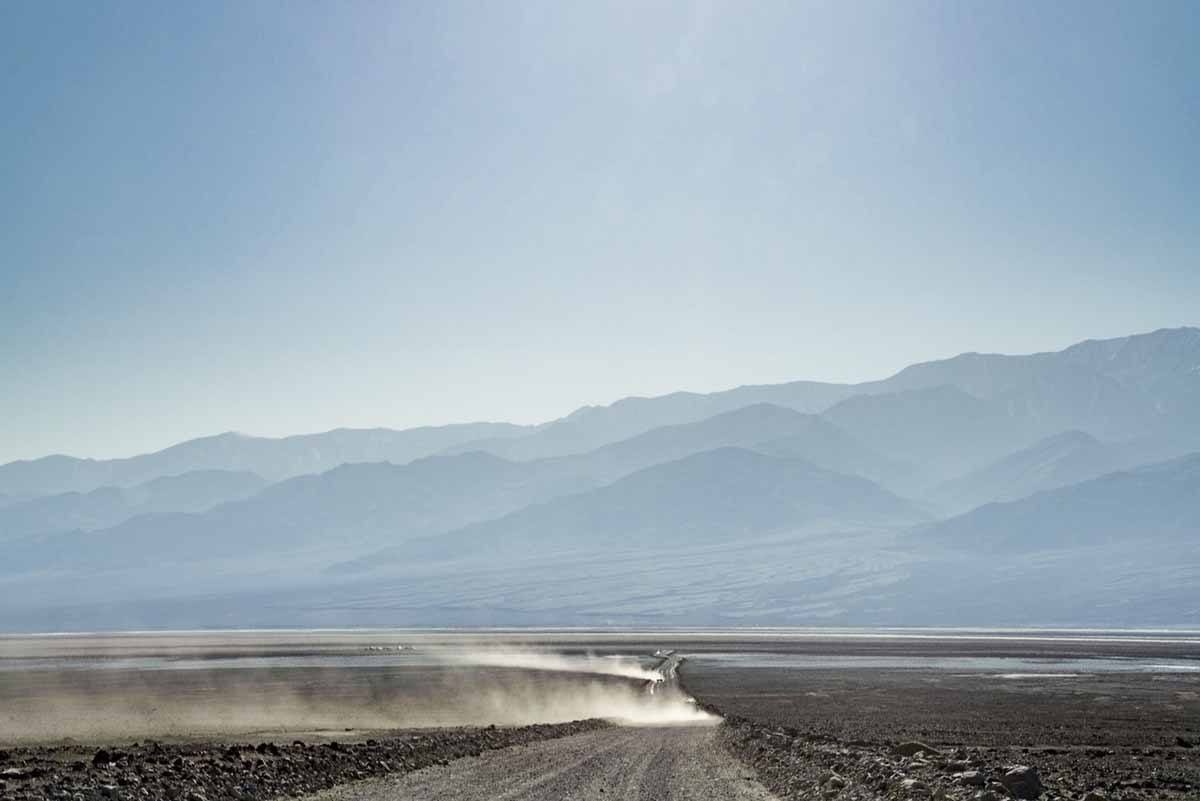
Where to Stay in Death Valley
Inside the National Park
-Camping: the most affordable way to stay inside Death Valley National Park is definitely camping. There are several campsites around the park, varying in terms of facilities, and opening times. The campsite at Furnace Creek is the only one that can be reserved in advance, all the others are available on a first come, first served basis.
You can find more info about camping in Death Valley on this page on the NPS website.
-The Oasis at Death Valley Resort: this resort located in Furnace Creek is by far the best place to stay in the national park.
It is made up of two separate properties – The Inn at Death Valley, a luxury hotel dating back to the early 20th century with a spring-fed pool, and The Ranch at Death Valley, offering slightly more affordable motel-style accommodation.
-Stovepipe Wells: this is the second of the three accommodation options inside the hotel. It’s a Western-themed hotel with a saloon, restaurant and heated outdoor pool.
The main benefits of staying here are that rates are considerably cheaper than the Oasis at Death Valley, and it’s in an official dark sky viewing area. There is also an adjacent campsite and RV park.
-Panamint Springs: here you’ll find the most budget-friendly option inside Death Valley National Park.
Outside the National Park
The three hotels located inside Death Valley National Park are all quite steeply priced, and fill up fast in winter considering it’s also high season.
For something a little more budget-friendly, you may look for hotels in Beatty or Pahrump, two Nevada towns about 40 minutes away from the park. Here are some options!
- Best Western Pahrump Oasis – fantastic midrange option with excellent breakfast!
- Holiday Inn Express & Suites – motel-style accommodation with pool and gym
- Saddle West Casino Hotel – perfect if you’re a casino lover!
- Death Valley Inn & RV Park – with outdoor pool, hot tub and barbecue facilities
- El Portal Motel – great budget option with a seasonal swimming pool

Thank you so much for a great overview of the traveling in Death Valley!